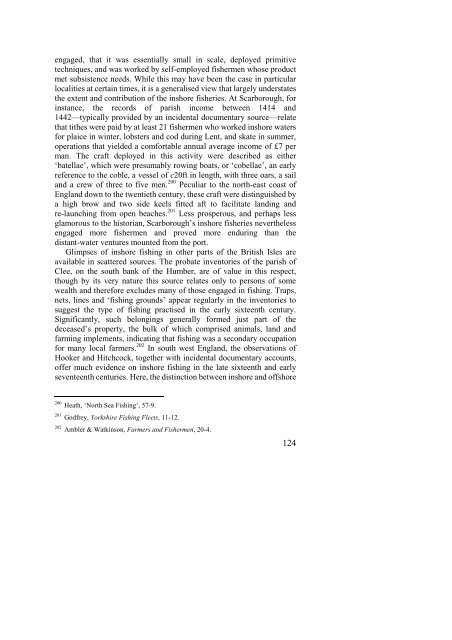The North Atlantic Fisheries, 1100-1976 - University of Hull
The North Atlantic Fisheries, 1100-1976 - University of Hull
The North Atlantic Fisheries, 1100-1976 - University of Hull
Create successful ePaper yourself
Turn your PDF publications into a flip-book with our unique Google optimized e-Paper software.
engaged, that it was essentially small in scale, deployed primitive<br />
techniques, and was worked by self-employed fishermen whose product<br />
met subsistence needs. While this may have been the case in particular<br />
localities at certain times, it is a generalised view that largely understates<br />
the extent and contribution <strong>of</strong> the inshore fisheries. At Scarborough, for<br />
instance, the records <strong>of</strong> parish income between 1414 and<br />
1442—typically provided by an incidental documentary source—relate<br />
that tithes were paid by at least 21 fishermen who worked inshore waters<br />
for plaice in winter, lobsters and cod during Lent, and skate in summer,<br />
operations that yielded a comfortable annual average income <strong>of</strong> £7 per<br />
man. <strong>The</strong> craft deployed in this activity were described as either<br />
‘batellae’, which were presumably rowing boats, or ‘cobellae’, an early<br />
reference to the coble, a vessel <strong>of</strong> c20ft in length, with three oars, a sail<br />
and a crew <strong>of</strong> three to five men. 200 Peculiar to the north-east coast <strong>of</strong><br />
England down to the twentieth century, these craft were distinguished by<br />
a high brow and two side keels fitted aft to facilitate landing and<br />
re-launching from open beaches. 201 Less prosperous, and perhaps less<br />
glamorous to the historian, Scarborough’s inshore fisheries nevertheless<br />
engaged more fishermen and proved more enduring than the<br />
distant-water ventures mounted from the port.<br />
Glimpses <strong>of</strong> inshore fishing in other parts <strong>of</strong> the British Isles are<br />
available in scattered sources. <strong>The</strong> probate inventories <strong>of</strong> the parish <strong>of</strong><br />
Clee, on the south bank <strong>of</strong> the Humber, are <strong>of</strong> value in this respect,<br />
though by its very nature this source relates only to persons <strong>of</strong> some<br />
wealth and therefore excludes many <strong>of</strong> those engaged in fishing. Traps,<br />
nets, lines and ‘fishing grounds’ appear regularly in the inventories to<br />
suggest the type <strong>of</strong> fishing practised in the early sixteenth century.<br />
Significantly, such belongings generally formed just part <strong>of</strong> the<br />
deceased’s property, the bulk <strong>of</strong> which comprised animals, land and<br />
farming implements, indicating that fishing was a secondary occupation<br />
for many local farmers. 202 In south west England, the observations <strong>of</strong><br />
Hooker and Hitchcock, together with incidental documentary accounts,<br />
<strong>of</strong>fer much evidence on inshore fishing in the late sixteenth and early<br />
seventeenth centuries. Here, the distinction between inshore and <strong>of</strong>fshore<br />
200 Heath, ‘<strong>North</strong> Sea Fishing’, 57-9.<br />
201 Godfrey, Yorkshire Fishing Fleets, 11-12.<br />
202 Ambler & Watkinson, Farmers and Fishermen, 20-4.<br />
124















